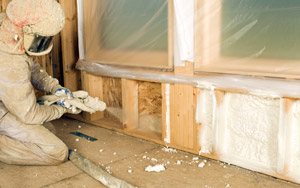
Expert Vinyl Siding and Steel Siding Installation in St. Louis, St. Charles, Florissant, Ballwin, MO and IL
 Give your house a dramatic makeover with exterior siding that’s beautiful, durable, and maintenance free
Give your house a dramatic makeover with exterior siding that’s beautiful, durable, and maintenance free
Of all the different exterior siding choices available today, steel and vinyl siding stand out for the excellent value they offer. Both of these materials shed moisture rather than absorbing it. They won’t support mold or mildew; nor will they succumb to moisture damage.
Steel and vinyl siding are designed to look good for many years, retaining their original color despite extreme exposure to the elements. And they deliver this impressive performance without requiring any maintenance. Your installation expense is your only expense.
Steel siding has an impressive track record
Don’t forget the windows!
An old window stands out like a sore thumb when a house gets new siding. Older windows also waste energy, compromise interior comfort and require regular painting. For the ultimate exterior makeover, consider having our premium vinyl replacement windows installed along with your new siding. Low-e, argon-filled insulated glass and advanced vinyl construction mean you’ll get maximum energy savings and totally maintenance-free windows.
Clean those vents professionally every 1-3 years. It's also a good idea to never run your dryer when you're sleeping or are away from home.
Steel exterior siding is different from aluminum siding. The former is stronger and more impact-resistant than the latter. Installing steel siding on a new or existing house is probably as close as you’ll come to giving your home a Kevlar® vest.
Fireproof and far more resistant to denting, bending and crimping than aluminum siding, steel siding has been in common use on houses since the 1950’s. Even before then, it proved its worth on farm and commercial buildings.
Steel siding is a green product, formed from American-made steel rather than from petroleum products. Unlike vinyl siding, steel siding can easily be recycled.
Today’s steel siding comes in a variety of popular colors and profiles. Horizontal and vertically oriented siding installations are possible. Thanks to a galvanizing treatment and a high-tech, multi-layer finishing process, today’s steel siding carries an unprecedented warranty against fading, corrosion and hail damage.
Vinyl siding can look as good as real wood
Made primarily from PVC (polyvinyl chloride) resins, vinyl siding was first manufactured in the 1950s, but the widespread use of this siding material didn’t begin until the late 1970s.
Just like steel siding, vinyl siding offers the advantages of zero maintenance, immunity to mold and moisture damage and plenty of styles and colors to choose from. In better-quality vinyl siding, a woodgrain surface texture can make the product look surprisingly like real wood. Better grades of vinyl siding also tend to be thicker, for improved rigidity and greater impact resistance.
Because PVC expands and contracts significantly in response to temperature changes, it can’t be solidly nailed to wall sheathing. Instead, each course of siding “floats” on slotted nailing fins.
Foam insulation options provide energy savings when installing new siding
 If you’re planning to have steel or vinyl siding installed, it’s smart to ask about rigid foam insulation that can be installed beneath or integrally with the siding. This added layer of insulation improves the R-value of your exterior walls, helping your house to retain heat during winter months, and keeping heat out during the cooling season. A layer of rigid foam insulation can be installed beneath the new siding, or you can buy your siding with the foam already attached to each siding course or panel.
If you’re planning to have steel or vinyl siding installed, it’s smart to ask about rigid foam insulation that can be installed beneath or integrally with the siding. This added layer of insulation improves the R-value of your exterior walls, helping your house to retain heat during winter months, and keeping heat out during the cooling season. A layer of rigid foam insulation can be installed beneath the new siding, or you can buy your siding with the foam already attached to each siding course or panel.
Well-crafted trim details complete your exterior transformation
The overall impression created by new siding is as much about trim details as it is about the siding itself. In a truly professional installation, the corner trim, J-channels, soffit panels, gutters and downspouts all look good together.
Compatibly colored caulks and sealants should also be used. Make sure to discuss these details along with your siding choices when planning your new siding installation.
For a siding price estimate contact Roofers Nation today! We work in St. Louis, St. Charles, Florissant, Ballwin, Chesterfield, O Fallon, Granite City, Saint Peters and nearby.
Looking for a price? Get a no cost, no obligation free estimate.


